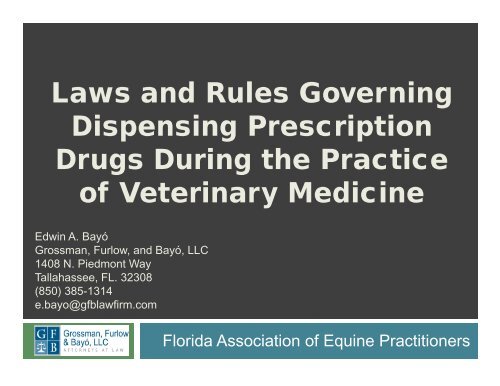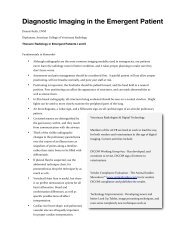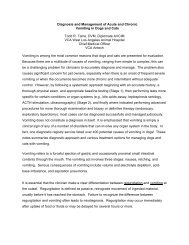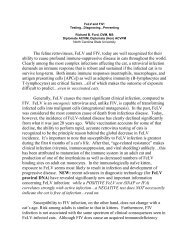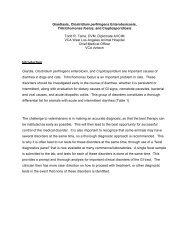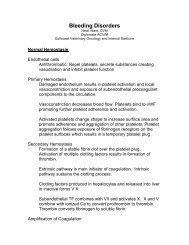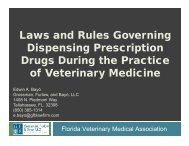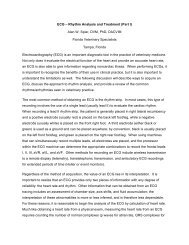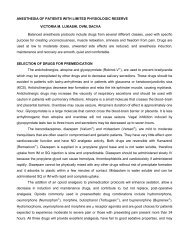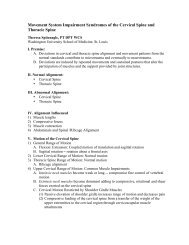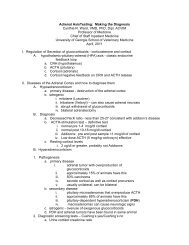Dispensing Legend Drugs
Dispensing Legend Drugs
Dispensing Legend Drugs
You also want an ePaper? Increase the reach of your titles
YUMPU automatically turns print PDFs into web optimized ePapers that Google loves.
Laws and Rules Governing<br />
<strong>Dispensing</strong> i Prescription<br />
<strong>Drugs</strong> During the Practice<br />
of Veterinary Medicine<br />
Edwin A. Bayó<br />
Grossman, Furlow, and Bayó, LLC<br />
1408 N. Piedmont Way<br />
Tallahassee, FL. 32308<br />
(850) 385-1314<br />
e.bayo@gfblawfirm.com<br />
Florida Association of Equine Practitioners
Section 1<br />
Veterinary Prescription <strong>Drugs</strong>
Veterinary Prescription <strong>Drugs</strong><br />
Veterinary prescription drugs are labeled for use<br />
only by or on the order of a licensed<br />
veterinarian.<br />
Veterinary prescription drugs are used or<br />
prescribed only within the context of a valid<br />
veterinarian/client/patient relationship (VCPR).<br />
A veterinarian can be disciplined for “using the<br />
privilege of ordering, prescribing, or making<br />
available medicinal drugs” outside of a VCPR.<br />
§474.214(1)(y), F.S.
Veterinary Prescription <strong>Drugs</strong><br />
<br />
<br />
Veterinary yprescription<br />
p<br />
drugs must be properly<br />
labeled before being<br />
dispensed. dspe sed<br />
Appropriate dispensing<br />
and treatment records<br />
must be maintained, and<br />
veterinary prescription<br />
drugs should be<br />
dispensed d only in<br />
quantities required for<br />
the treatment of the<br />
animal(s) for which the<br />
drugs are dispensed.
Veterinarian/Client/Patient<br />
Relationship<br />
A VCPR exists when all of the following<br />
conditions have been meet:<br />
1. The veterinarian has sufficient knowledge of the<br />
animal(s) to initiate at least a general or<br />
preliminary diagnosis of the medical condition of<br />
the animal(s), which h means that t the veterinarian<br />
i<br />
is personally acquainted with the keeping and<br />
caring of the animal(s) and has seen the<br />
animal(s) or has made medically appropriate<br />
and timely visits to the premises where the<br />
animal(s) are kept.
Veterinarian/Client/Patient<br />
Relationship (continued)…<br />
2 The veterinarian is available or provides for<br />
2. The veterinarian is available or provides for<br />
follow up care and treatment in case of an<br />
adverse reaction or failure of the regimen of<br />
therapy.<br />
3. Maintains records which document patient<br />
visits, diagnosis, treatment, and other relevant<br />
information.
Section 2<br />
Federal Laws
U.S. Drug Enforcement<br />
Agency
DEA Registration<br />
In order for Florida licensed veterinarians to be<br />
able to prescribe, administer or dispense<br />
controlled substances, they must be registered<br />
with the U.S. Drug Enforcement Agency (DEA).<br />
DEA Form-224<br />
Available online and can be submitted electronically:<br />
www.deadiversion.usdoj.gov/drugreg/process.htm<br />
Send by U.S. Mail:<br />
DEA Registration ti Unit<br />
Registration Section/ODR<br />
P.O. Box 2639<br />
Springfield, VA 22152-2639
Source: An Informational Outline of the Controlled Substances Act (2006 ed.)
DEA Registration<br />
Veterinarians who practice at multiple locations<br />
must be registered with the DEA at each location.<br />
The only exception is the practitioner who uses or<br />
dispenses controlled substances as an agency of<br />
a veterinarian who is registered at each location.<br />
You must furnish your DEA registration number to<br />
obtain Schedule III, IV, and V controlled<br />
substances from suppliers. Veterinarians must<br />
use DEA Triplicate Order Form-222 to obtain<br />
Schedule II substances.
DEA Registration: Mobile<br />
Clinics<br />
Veterinarians who<br />
operate mobile clinics<br />
would be registered at<br />
the location where the<br />
controlled substances<br />
are stored.<br />
Records should be<br />
maintained as if the<br />
mobile unit were part<br />
of the registrant’s<br />
permanent location.
DEA Registration Modification<br />
Practitioners who wish to modify their Drug<br />
Enforcement Administration Registration for a<br />
name change or change of address should let<br />
their local DEA office know ahead of time, so<br />
appropriate registration changes can be made.<br />
Information concerning the DEA registration<br />
process can also be obtained by contacting<br />
the Registration Call Center at (800) 882-<br />
9539.
DEA Registration Renewal<br />
The DEA Form 224a is currently available online.<br />
Renewal applications are mailed automatically to<br />
the registered location 60 days prior to the<br />
expiration date.<br />
Any changes of address must be reported in<br />
writing to the DEA at the time the change occurs<br />
so that the renewal application will be sent to the<br />
correct address.<br />
Renewal applications will not be forwarded by the<br />
Post Office. If you are moving to a new state, t the<br />
DEA asks that you submit a copy of the new state<br />
license and a copy of the state controlled<br />
substance bt registration. it ti
DEA Registration Renewal<br />
Certificates must renewed every three (3)<br />
years.<br />
Cost of the registration fee, background check,<br />
etc. are the responsibility of the requesting<br />
veterinarian.
Source: An Informational Outline of the Controlled Substances Act (2006 ed.)
DEA Inspections<br />
<br />
<br />
The DEA does not routinely<br />
investigate t veterinary clinics, i but if<br />
an inspection does take place,<br />
organization and accurate records<br />
are essential. The DEA’s descent<br />
on a clinic will not allow the<br />
owner(s) time to search for files-<br />
one must be able to immediately<br />
access critical information.<br />
Situations that may provoke an<br />
investigation include those<br />
involving unusual prescribing<br />
practices, reports of controlled<br />
substance abuse, diversion, or<br />
other illegal activity.
DEA Identification of<br />
Controlled Substances<br />
Controlled substances are labeled with a<br />
large “C” and contain a roman numeral in<br />
the center to identify the schedule of the<br />
substance.<br />
The drugs and drug products that come<br />
under the jurisdiction of the Controlled<br />
Substance Act are divided into 5 schedules.<br />
These schedules are:
Controlled Substances Act:<br />
Drug Scheduling<br />
Schedule Description: Examples:<br />
I.<br />
The drug or other substance has a high<br />
potential for abuse. The drug or other<br />
substance has no currently accepted<br />
medical use in treatment in the United<br />
States.<br />
GHB, Heroin, Cannabis,<br />
Ecstasy, LSD.<br />
II.<br />
The drug or other substance has a high<br />
potential for abuse. The drug or other<br />
substance has a currently accepted<br />
medical use in treatment in the United<br />
States or a currently accepted medical<br />
use with severe restrictions. Abuse of<br />
the drug or other substances may lead<br />
to severe psychological l or physical<br />
dependence<br />
Cocaine, Codeine,<br />
Opium, Oxycodone,<br />
Morphine, Dexedrine.
Controlled Substances Act:<br />
Drug Scheduling (continued)<br />
Schedule Description: Examples:<br />
III.<br />
The drug or other substance has a<br />
potential for abuse less than the drugs<br />
or other substances in Schedules I and<br />
II. The drug or other substance has a<br />
currently accepted medical use in<br />
treatment in the United States. Abuse<br />
of the drug or other substance may<br />
lead to moderate or low physical<br />
dependence or high psychological<br />
dependence.<br />
Anabolic steroids;<br />
Intermediate-acting<br />
barbiturates, such as<br />
talbutal or butalbital;<br />
Buprenorphine;<br />
Ketamine; Xyrem;<br />
Hydrocodone / codeine,<br />
when compounded with<br />
an NSAID
Controlled Substances Act:<br />
Drug Scheduling (continued)<br />
Schedule Description: Examples:<br />
IV.<br />
The drug or other substance has a low<br />
potential for abuse relative to the drugs<br />
or other substances in Schedule III.<br />
The drug or other substance has a<br />
currently accepted medical use in<br />
treatment in the United States.<br />
Abuse of the drug or other substance<br />
may lead to limited physical<br />
dependence or psychological<br />
dependence relative to the drugs or<br />
other substances in Schedule III.<br />
Xanax, Stadol, Librium,<br />
Klonopin, Ativan, Restoril,<br />
Ambien, Serax
Controlled Substances Act:<br />
Drug Scheduling (continued)<br />
Schedule Description: Examples:<br />
V.<br />
The drug or other substance has a low<br />
potential for abuse relative to the drugs<br />
or other substances in Schedule IV.<br />
The drug or other substance has a<br />
currently accepted medical use in<br />
treatment in the United States.<br />
Abuse of the drug or other substance<br />
may lead to limited physical<br />
dependence or psychological<br />
dependence relative to the drugs or<br />
other substances in Schedule IV<br />
Cough suppressants<br />
containing small amounts<br />
of codeine (e.g.,<br />
promethazine+codeine);<br />
Preparations containing<br />
small amounts of opium<br />
or diphenoxylate (used to<br />
treat diarrhea);<br />
Pyrovalerone.
Ordering Controlled<br />
Substances<br />
Due to their potential for addiction, Schedule II<br />
drugs get more attention during their<br />
manufacturing, distribution, and dispensing.<br />
To order Schedule II substances, a federal<br />
triplicate order form must be used. These<br />
forms can be obtained by requesting them on<br />
the initial application form (DEA-224) by<br />
checking block “3.”<br />
They may also be obtained from the DEA<br />
Registration Unit in Washington, D.C. or online<br />
at https://www.deadiversion.usdoj.gov.<br />
di i d
Ordering Controlled<br />
Substances<br />
When using the DEA Triplicate Order Form-<br />
222 to obtain Schedule II substances, be sure<br />
to:<br />
Fill out the correctly or it will be sent back to the<br />
supplier.<br />
Fill in the “number of packages” and the “date<br />
received” sections.
Source: An Informational Outline of the Controlled Substances Act (2006 ed.)
Ordering Controlled<br />
Substances<br />
All other controlled substances are ordered in the<br />
same manner as any other medication. The<br />
supplier will ask for a copy of your current DEA<br />
registration form.<br />
There are no special requirements for Schedule<br />
III, IV, and V purchases.<br />
Obtaining controlled substances from a local<br />
pharmacy for “in-house” or “re-sale” use is<br />
prohibited.<br />
Prescriptions for controlled substances to be filled<br />
by a local pharmacy should be written only for<br />
specific patients.
DEA Records and<br />
Prescriptions<br />
Veterinarians must keep records for all<br />
controlled substances used or dispensed.<br />
These must be kept for 3 years by Florida law.<br />
Records for Schedule III, IV, and V controlled<br />
substances can be maintained as part of<br />
patient t records, by must be readily retrievable.<br />
Schedule II records must be kept separately.<br />
You must maintain i records or invoices i of<br />
controlled substances received for a 2 year<br />
period after the last quantity of each controlled<br />
substance on the invoice has been depleted.
DEA Records and<br />
Prescriptions<br />
You might be required to keep a copy of each<br />
prescription issued. Although the DEA does<br />
not require registrants to keep records of<br />
prescriptions issued, approximately 40% of<br />
states require multiple copies of controlled<br />
substance prescriptions.<br />
Prescriptions for Schedule II drugs must be in<br />
writing and cannot be refilled. Prescriptions<br />
for Schedule III or IV may be issued orally or in<br />
writing and can be refilled only up to five times<br />
in 6 months.
DEA Records and<br />
Prescriptions<br />
In emergencies, a<br />
pharmacist may fill<br />
oral prescriptions for<br />
Schedule II drugs<br />
but must notify the<br />
DEA if a written<br />
prescription order is<br />
not received within<br />
72 hours.
DEA: Biennial Inventory<br />
In addition to an initial inventory, yyou must make a<br />
biennial inventory of all controlled substances on<br />
hand. The inventory must be made every 2 years<br />
from initial registration and opening inventory.<br />
The following information should be included:<br />
1. Name, address, and registration number of each<br />
registrant.<br />
2. Name, unit size, and total quantity of each controlled<br />
substance.<br />
3. Date and time of inventory.<br />
4. Signature of person(s) making the inventory<br />
5. Separate records for Schedule II drugs.<br />
6. And new controlled drugs introduced must be put on<br />
inventory list with quantity and date.
DEA: Transfers of<br />
Controlled Substances<br />
You may transfer or receive a limited amount of<br />
controlled substances to or from another<br />
practitioner if you are both DEA registrants. Both<br />
registrants must maintain records of the<br />
transaction.<br />
Records of Schedule II controlled substance<br />
transfers must be kept on DEA Order Form-222.<br />
Records of Schedule III, IV, and V controlled<br />
substances bt may be in the form of finvoices.<br />
i<br />
The total amount transferred by a registrant must<br />
not be more that 5% of the total number of dosage<br />
units used, dispensed, or prescribed during the<br />
same calendar year.
DEA: Safety Requirements<br />
You must keep<br />
controlled<br />
substances in a<br />
securely locked,<br />
substantially<br />
constructed cabinet<br />
or safe.
DEA: Safety Requirements<br />
If a moveable lock-box is used, it must be<br />
securely affixed to a wall, floor, or cabinet.<br />
Similarly, lightweight filling cabinets or fire<br />
safes are inappropriate since they can be<br />
easily picked up and removed.<br />
Mobile units should be stocked with only<br />
enough of each controlled drug necessary for<br />
basic operation.<br />
Excess supplies should remain in a fixed<br />
secure location.
DEA: Safety Requirements<br />
There are no additional security requirements<br />
for vehicles other than a substantial container<br />
must be used if the vehicle is unsupervised<br />
(i.e.. parking lot or store).<br />
Keeping drugs in a bag is not adequate. If the<br />
vehicle is not equipped with locking bins or<br />
compartments, then a small lockable box<br />
should be affixed to the vehicle.<br />
It is not necessary to remove the drugs from<br />
the vehicle for storage if a strong, non-<br />
moveable safe box is available.
DEA: Safety Recommendations<br />
It is recommended that the controlled<br />
substance stocks be kept to a minimum.<br />
Should it be necessary to have a substantial<br />
quantity of controlled substances stored in the<br />
clinic, the DEA encourages having security,<br />
which exceeds the minimum requirements,<br />
such as a large safe and alarm system.<br />
Access to the controlled substance storage<br />
area should be restricted to the absolute<br />
minimum number of employees.
DEA: Accountability of<br />
Controlled Substances<br />
Whenever a practice administers a controlled<br />
substance to a patient, it must be recorded<br />
both on the patient’s medical record AND a<br />
“readily retrievable” log or controlled<br />
substance record.<br />
See §893.07, F.S.- Records
DEA: Theft And Loss Reporting<br />
You must report thefts or other losses of<br />
controlled substances or records promptly to<br />
the DEA.<br />
Completing DEA Form-106 is required in such<br />
cases.
DEA Form-106 Report of Theft or<br />
Loss of Controlled Substances<br />
Source: An Informational Outline of the Controlled Substances Act (2006 ed.)
U.S. Food and Drug<br />
Administration
Food, Drug, & Cosmetic Act<br />
Under the FD&C section of Title 21 of the<br />
United States Code, the FDA’s Center for<br />
Veterinary Medicine has been given the<br />
authority to govern the manufacture,<br />
distribution, and use of veterinary drugs that<br />
are distributed between states.<br />
The Federal Code also gives the FDA the<br />
authority to write regulations on how it will<br />
enforce the FD&C Act. Those regulations are<br />
contained in the Code of Federal Regulations<br />
Title 21.
The Food and Drug<br />
Modernization Act of 1997<br />
Signed into law in November of 1997 and fully<br />
enacted in April of 1999, the Act (among many<br />
other things) called for:<br />
A reduction in the time for the approval of new<br />
pharmaceutical drugs.<br />
Relaxed medical device regulations.<br />
Restricted the advertising of compounded<br />
drugs, i.e. mixtures made up by pharmacists.<br />
This provision was overturned by the US<br />
Supreme Court in 2002 on grounds of freedom<br />
of speech.
Obtaining Approval: New<br />
Animal Drug Applications<br />
Section 512 of the FD&C Act outlines the rules<br />
that govern the safety and efficacy of new<br />
animal drugs.<br />
The Code of Federal Regulations (CFR)<br />
details the requirements of submissions<br />
demonstrating the safety and efficacy of a drug<br />
before approval can be granted.<br />
The new animal drug approval (NADA)<br />
process is extremely complicated and has so<br />
far proved a very effective safeguard.
Extra-Label Drug Use (ELDU)<br />
"Extra-label use" is defined as:<br />
"Actual use or intended use of a drug in an<br />
animal in a manner that is not in accordance<br />
with the approved labeling. This includes, but<br />
is not limited to, use in species not listed in the<br />
labeling, use for indications (disease and other<br />
conditions) not listed in the labeling, use at<br />
dosage levels, frequencies, or routes of<br />
administration other than those stated in the<br />
labeling, li and deviation from labeled l withdrawal<br />
time based on these different uses."
Extra-Label Drug Use<br />
Under the provisions of the Animal Medicinal<br />
Drug Use Clarification Act of 1994, the FDA<br />
recognizes the professional judgment of<br />
veterinarians, i and allows the extra-label l use of<br />
drugs by veterinarians under certain conditions<br />
(21 CFR 530).<br />
Any drug used in an extra-label manner is by<br />
definition a prescription p drug since the<br />
involvement of a veterinarian is required.<br />
Extra-label use of drugs may only take place<br />
within the scope of a valid veterinarian-client-<br />
i t<br />
patient relationship (VCPR)
Extra-Label Drug Use<br />
In the absence of a<br />
valid VCPR, if an<br />
approved new animal<br />
drug is used for a use<br />
for which it is not<br />
labeled, such use has<br />
caused dthe drug to be<br />
deemed unsafe and<br />
therefore adulterated<br />
under the Act (21<br />
U.S.C. 351(a)(5)).
Extra-Label Drug Use<br />
The FDA has taken legal action against<br />
veterinarians who were responsible for<br />
creating violative drug tissue residues in the<br />
human food supply, especially when these<br />
were the result of drugs used contrary to label<br />
instructions.<br />
Nevertheless, extra-label drugs used in<br />
treating food-producing animals may be<br />
considered by a veterinarian when the health<br />
of animals is immediately threatened and<br />
suffering or death would result from failure to<br />
treat the affected animals.
Labeling of drugs prescribed<br />
for extra-label use<br />
At a minimum, the following label information is recommended:<br />
1. The name and address of the prescribing veterinarian.<br />
2. The established name of the drug (active ingredient), or if<br />
formulated from more than one ingredient, the established<br />
name of each ingredient.<br />
3. Any directions for use specified by the practitioner (including<br />
class/species or identification of the animals; dosage,<br />
frequency, and route of administration; and, duration of<br />
therapy).<br />
4. Any cautionary statements specified by the veterinarian.<br />
5. The veterinarian's specified withdrawal/discard time(s) for<br />
meat, milk, eggs, or any food which h might be derived d from<br />
the treated animals.
<strong>Drugs</strong> Prohibited for Extra-<br />
Label Use in Food Animals:<br />
Chloramphenicol; Sulfonamide drugs in<br />
Clenbuterol;<br />
lactating dairy cattle<br />
(except approved use<br />
Diethylstilbestrol<br />
of sulfadimethoxine,<br />
(DES);<br />
sulfabromomethazine,<br />
Dimetridazole;<br />
and<br />
<br />
Ipronidazole;<br />
sulfaethoxypyridazine);<br />
i Other nitroimidazoles; Fluoroquinolones;<br />
<br />
Furazolidone;<br />
<br />
Phenylbutazone in<br />
Nitrofurazone;<br />
female dairy cattle 20<br />
months of age or older.<br />
<br />
Glycopeptides;
Compounding Under<br />
AMDUCA<br />
Animal Medicinal Drug Use Clarification Act<br />
The extra-label drug use regulation also<br />
provides for the legal compounding of animal<br />
drugs from approved animal drugs and<br />
approved human drugs. The compounding<br />
must be in compliance with the provisions of<br />
this regulation. The regulation provides<br />
additional requirements for extra-label<br />
compounding (21 CFR 530.13).<br />
The extra-label drug use regulation does not<br />
allow for legal l animal drug compounding from<br />
active pharmaceutical ingredients (bulk drugs).
Human-Label Drug Products<br />
Veterinarians, as licensed health professionals,<br />
must have the right to purchase or prescribe<br />
human-labeled prescription drugs and to use them<br />
according to their best medical judgment in<br />
compliance with relevant laws and regulations.<br />
The FDA has confirmed that manufacturers may<br />
legally sell human-labeled prescriptions drugs to<br />
veterinarians upon their order.<br />
Veterinarians have full responsibility when using<br />
human-labeled prescription products in the<br />
treatment of animals, and must recognize that<br />
manufacturers cannot promote the sale of those<br />
products to veterinarians.
Adulterated <strong>Drugs</strong><br />
Under Section 301 of the FD&C Act, the<br />
introduction or delivery into interstate commerce<br />
of any food, drug, device, or cosmetic that is<br />
adulterated is prohibited.<br />
Section 501 of Title 21 defines what constitutes an<br />
adulterated drug.<br />
Simply stated, drugs that contain unsanitary<br />
components, lack adequate control in<br />
manufacture, differ in strength th from that<br />
t<br />
recognized in the official compendium, or that are<br />
mixed with another substance to reduce their<br />
quality or strength are considered to have been<br />
adulterated.
Compounding<br />
The Federal Food, Drug, and Cosmetic Act (the<br />
Act) does not distinguish compounding from<br />
manufacturing or other processing of drugs for<br />
use in animals.<br />
FDA acknowledges the use of compounding<br />
within certain areas of veterinary practice.<br />
The current state of veterinary medicine requires<br />
products to treat many conditions in a number of<br />
different species, some of which are known to<br />
have unique physiological characteristics.<br />
Furthermore, FDA regulations specifically permit<br />
the compounding of products from approved<br />
animal or human drugs under the conditions set<br />
forth in 21 CFR 530.13.
Compounding<br />
However, the FDA is<br />
greatly concerned<br />
about veterinarians and<br />
pharmacies that are<br />
engaged in<br />
manufacturing and<br />
distributing unapproved<br />
new animal drugs in a<br />
manner that is clearly<br />
outside the bounds of<br />
traditional pharmacy<br />
practice and that<br />
violates the Act
Compounding<br />
With regard to compounding from bulk drug<br />
substances, two Federal Appeals Court<br />
decisions, United States v. Algon Chemical<br />
Inc., 879 F.2d 1154 (3d Cir. 1989) and United<br />
States v. 9/1 Kg. Containers, 854 F.2d 173 (7th<br />
Cir. 1988), affirmed the FDA position that the<br />
Act does not permit veterinarians to compound<br />
unapproved finished drug products from bulk<br />
drug substances, unless the finished i drug is<br />
not a new animal drug.<br />
The principle established by the court applies<br />
The principle established by the court applies<br />
equally to compounding by pharmacists.
Compounding<br />
Neither the Act nor its implementing regulations<br />
exempt veterinarians or pharmacists from the<br />
approval requirements in the new animal drug<br />
provisions of the Act, 21 U.S.C. Section 360b.<br />
In the absence of an approved new animal drug<br />
application, the compounding of a new animal<br />
drug from any unapproved drug or from bulk drug<br />
substances results in an adulterated new animal<br />
drug in violation of section 21 U.S.C. Section<br />
351(a)(5).<br />
The compounding of a new animal drug from an<br />
approved human or animal drug also results in an<br />
adulterated new animal drug in violation of 21<br />
U.S.C. Section 351(a)(5), unless the conditions<br />
set forth in 21 CFR 530.13(b) are met.
Compounding<br />
<br />
<br />
Generally, FDA will defer to state authorities regarding g the day-<br />
to-day regulation of compounding by veterinarians and<br />
pharmacists of animal and human drugs that are intended for<br />
use in animals. FDA anticipates that, in such cases, cooperative<br />
efforts between the states and the Agency will result in<br />
coordinated investigations, referrals, and follow-up actions by<br />
the states.<br />
However, when the scope and nature of activities of<br />
veterinarians and pharmacists raise the kinds of concerns<br />
normally associated with a drug manufacturer and result in<br />
significant violations of the new animal drug, adulteration, or<br />
misbranding provisions of the Act, FDA has determined that it<br />
will seriously consider enforcement action.
Compounding<br />
<br />
<br />
The FDA chooses to enforce its “regulatory discretion” and<br />
“ordinarily” will not take regulatory action when:<br />
1. A legitimate need is identified.<br />
2. There is a need for an appropriate dosage regimen for the<br />
particular species, size, age, or medical condition, and<br />
3. There is no marketed approved animal drug which, when<br />
used in conformity with the regulations as set forth<br />
AMDUCA, may treat the condition diagnosed in the<br />
available dosage form, or there is some other rare<br />
extenuating circumstance.<br />
The FDA places its highest priority on compounding products for<br />
use in food animals.
Compounding in Florida<br />
<br />
Rule 64B16-27.700, F.A.C.- Definition of Compounding:<br />
“Compounding” is the professional act by a pharmacist or<br />
other practitioner authorized by law, employing the science<br />
or art of any branch of the profession of pharmacy,<br />
incorporating ingredients to create a finished product for<br />
dispensing to a patient or for administration by a<br />
practitioner or the practitioner’s agent; and shall specifically<br />
include the professional act of preparing a unique finished<br />
product containing any ingredient or device defined by<br />
Sections 465.003(7) and (8), F.S.<br />
(1) Compounding includes:
Compounding in Florida<br />
(a) The preparation of drugs or devices in anticipation of<br />
prescriptions based on routine, regularly observed prescribing<br />
patterns.<br />
(b) The preparation pursuant to a prescription of drugs or<br />
devices which are not commercially available.<br />
(c) The preparation of commercially available products from bulk<br />
when the prescribing practitioner has prescribed the<br />
compounded product on a per prescription basis and the patient<br />
has been made aware that the compounded product will be<br />
prepared by the pharmacist. The reconstitution of commercially<br />
available products pursuant to the manufacturer’s guidelines is<br />
permissible without notice to the practitioner.<br />
(2) The preparation of drugs or devices for sale or transfer to<br />
pharmacies, practitioners, ii or entities ii for purposes of fdispensing<br />
i<br />
or distribution is not compounding.
Section 3<br />
State t Laws
Chapter 465, F.S.<br />
Chapter 465, F.S.<br />
Florida Pharmacy Act
§ 465.003, F.S.- Definitions:<br />
(8) "Medicinal drugs" or "drugs" means those<br />
substances or preparations commonly known as<br />
"prescription" or "legend" drugs which are<br />
required by federal or state law to be dispensed<br />
only on a prescription, but shall not include<br />
patents or proprietary preparations as hereafter<br />
defined.<br />
d<br />
(9) "Patent or proprietary preparation" means a<br />
medicine in its unbroken, original package which<br />
is sold to the public by, or under the authority of,<br />
the manufacturer or primary distributor thereof<br />
and which h is not misbranded d under the provisions<br />
i<br />
of the Florida Drug and Cosmetic Act.
§465.0255, F.S.- Expiration date of<br />
medicinal drugs; display; related use<br />
and storage instructions:<br />
ti<br />
(1) The manufacturer, repackager, or other distributor of<br />
any medicinal i drug shall display the expiration i date of<br />
each drug in a readable fashion on the container and on<br />
its packaging. The term "readable" means conspicuous<br />
and bold.<br />
(2) Each pharmacist for a community pharmacy<br />
dispensing medicinal drugs and each practitioner<br />
dispensing i medicinal i drugs on an outpatient ti t basis shall<br />
display on the outside of the container of each medicinal<br />
drug dispensed, or in other written form delivered to the<br />
purchaser:<br />
(a) The expiration date when provided by the manufacturer,<br />
repackager, or other distributor of the drug; or<br />
(b) An earlier beyond-use date for expiration, which may be up<br />
to 1 year after the date of dispensing.
§465.0255, F.S.- Expiration date of<br />
medicinal drugs; display; related use<br />
and storage instructions ti (continued):<br />
The dispensing pharmacist or practitioner must provide<br />
information i concerning the expiration i date to the purchaser<br />
upon request and must provide appropriate instructions<br />
regarding the proper use and storage of the drug.<br />
(3) This section does not impose liability on the dispensing<br />
pharmacist or practitioner for damages related to, or<br />
caused by, a medicinal drug that loses its effectiveness<br />
prior to the expiration date displayed d by the dispensing i<br />
pharmacist or practitioner.<br />
(4) The provisions of this section are intended to notify the<br />
patient t receiving i a medicinal i drug of the information<br />
required by this section, and the dispensing pharmacist<br />
or practitioner shall not be liable for the patient's failure<br />
to heed such notice or to follow the instructions for<br />
storage.
Other Pertinent Chap. 465<br />
Sections:<br />
§465.026, F.S.: Filling of certain prescriptions<br />
§465.0276, F.S.: <strong>Dispensing</strong> practitioner<br />
§465.035, F.S.: <strong>Dispensing</strong> of medicinal drugs<br />
pursuant tto facsimile il of prescription
Chapter 499, F.S.: <strong>Drugs</strong>, Devices,<br />
Chapter 499, F.S.: <strong>Drugs</strong>, Devices,<br />
Cosmetics, and Household Products
Chapter 499, F.S.: <strong>Drugs</strong>, Devices,<br />
Cosmetics, and Household Products.<br />
§499.003(52): "Veterinary yprescription p drug"<br />
means a prescription drug intended solely for<br />
veterinary use. The label of the drug must bear<br />
the statement, "Caution: Federal law restricts this<br />
drug to sale by or on the order of a licensed<br />
veterinarian."<br />
§ 499.006 Adulterated drug or device. --Adrug<br />
or device is adulterated:<br />
(11) If it is a prescription drug subject to, defined by,<br />
or described by s. 503(b) of the Federal Food, Drug,<br />
and Cosmetic Act which has been returned by a<br />
veterinarian to a limited prescription drug veterinary<br />
wholesale distributor.
Chapter 499, F.S.: <strong>Drugs</strong>, Devices,<br />
Cosmetics, and Household Products.<br />
499.005 Prohibited acts.--It is unlawful for a<br />
person to perform or cause the performance of<br />
any of the following acts in this state:<br />
(14) The purchase or receipt of a prescription<br />
drug from a person that is not authorized under<br />
this chapter to distribute prescription drugs to that<br />
purchaser or recipient.<br />
(15) The sale or transfer of a prescription drug to<br />
a person that is not authorized under the law of<br />
the jurisdiction in which the person receives the<br />
drug to purchase or possess prescription drugs<br />
from the person selling or transferring the<br />
prescription drug.
Chapter 499, F.S.: <strong>Drugs</strong>, Devices,<br />
Cosmetics, and Household Products.<br />
499.01 Permits:<br />
(j) A veterinary prescription drug retail<br />
establishment;<br />
(k) A veterinary prescription drug wholesale<br />
distributor;<br />
(l) A limited prescription drug veterinary<br />
wholesale distributor
Chapter 828, F.S.: Animals: Cruelty,<br />
Chapter 828, F.S.: Animals: Cruelty,<br />
Sales, Animal Enterprise Protection
Chapter 828, Florida Statutes<br />
Animals: Cruelty, Sales, Animal Enterprise<br />
Protection.<br />
§828.05: Killing an injured or diseased domestic<br />
animal.<br />
§828.055: Sodium pentobarbital; permits for<br />
use in euthanasia of domestic animals.
Chapter 828, Florida Statutes<br />
§828.058: Euthanasia of dogs and cats.<br />
§828.065: Euthanasia of animals offered for<br />
sale by pet shops.<br />
§828.29: Dogs and cats transported or offered<br />
for sale; health requirements; consumer<br />
guarantee.– Official certificates of veterinary<br />
inspection.
Chapter 893, F.S.<br />
Florida Comprehensive Drug Abuse<br />
Prevention and Control Act.
§893.02 Definitions<br />
<br />
"Practitioner" means a physician licensed<br />
pursuant to chapter 458, a dentist licensed<br />
pursuant to chapter 466, a veterinarian<br />
licensed pursuant to chapter 474, an<br />
osteopathic physician licensed pursuant to<br />
chapter 459, a naturopath licensed pursuant to<br />
chapter 462, or a podiatric physician licensed<br />
pursuant to chapter 461, provided such<br />
practitioner holds a valid federal controlled<br />
substance registry number.
§893.02 Definitions<br />
<br />
"Prescription" means and includes an order for drugs or<br />
medicinal i supplies written, signed, or transmitted by word of<br />
mouth, telephone, telegram, or other means of communication by<br />
a duly licensed practitioner licensed by the laws of the state to<br />
prescribe such drugs or medicinal supplies, issued in good faith<br />
and in the course of professional practice, intended to be filled,<br />
compounded, or dispensed by another person licensed by the<br />
laws of the state to do so, and meeting the requirements of s.<br />
893.04. The term also includes an order for drugs or medicinal<br />
supplies so transmitted or written by a physician, dentist,<br />
veterinarian, or other practitioner licensed to practice in a state<br />
other than Florida, but only if the pharmacist called upon to fill<br />
such an order determines, in the exercise of his or her<br />
professional judgment, that the order was issued pursuant to a<br />
valid patient-physician relationship, that it is authentic, and that the<br />
drugs or medicinal supplies so ordered ed are considered ed necessary<br />
for the continuation of treatment of a chronic or recurrent illness.
§893.02 Definitions<br />
Continued…<br />
However, if the physician writing the prescription is not<br />
known to the pharmacist, the pharmacist shall obtain<br />
proof to a reasonable certainty of the validity of said<br />
prescription. A prescription order for a controlled<br />
substance shall not be issued on the same<br />
prescription blank with another prescription order for a<br />
controlled substance which is named or described in a<br />
different schedule, nor shall any prescription order for<br />
a controlled substance be issued on the same<br />
prescription blank as a prescription order for a<br />
medicinal drug, as defined in 1 s. 465.031(5), which<br />
does not fall within the definition of a controlled<br />
substance as defined in this act.
§893.07: Records<br />
(3) The record of all controlled substances sold,<br />
administered, dispensed, or otherwise disposed of<br />
shall show:<br />
(a) The date of selling, administering, or<br />
dispensing.<br />
(b) The correct name and address of the person<br />
to whom or for whose use, or the owner and<br />
species of animal for which, sold,<br />
administered, or dispensed.<br />
(c) The kind and quantity of controlled substances<br />
sold, administered, or dispensed.
§893.07: Records<br />
(2) The record of controlled substances received<br />
shall in every case show:<br />
(a) The date of receipt.<br />
(b) The name and address of the person from<br />
whom received.<br />
(c) The kind and quantity of controlled substances<br />
received.
§893.07: Records<br />
(4) Every inventory or record required by this chapter, including<br />
prescription records, shall be maintained:<br />
i (a) Separately from all other records of the registrant, or<br />
(b) Alternatively, in the case of Schedule III, IV, or V controlled<br />
substances, in such form that t information required by this<br />
chapter is readily retrievable from the ordinary business<br />
records of the registrant.<br />
In either case, records shall be kept and made available for a period<br />
of at least 2 years for inspection and copying by law enforcement<br />
officers whose duty it is to enforce the laws of this state relating to<br />
controlled substances.<br />
(5) Each person shall maintain a record which shall contain a<br />
detailed d list of controlled substances lost, destroyed, d or stolen, if<br />
any; the kind and quantity of such controlled substances; and the<br />
date of the discovering of such loss, destruction, or theft.
Other Chapter 893 Provisions<br />
§893.04: Pharmacist and practitioner.<br />
§893.05: Practitioners and persons<br />
administering controlled substances in their<br />
absence.<br />
§893 055: Prescription drug monitoring<br />
§893.055: Prescription drug monitoring<br />
program.
Other Chapter 893 Provisions<br />
§893.0551: Public records exemption for the<br />
prescription drug monitoring program.<br />
§893.06: Distribution of controlled substances;<br />
order forms; labeling and packaging<br />
requirements.<br />
§893.065: Counterfeit-resistant prescription<br />
blanks for controlled substances listed in<br />
Schedule II, Schedule III, or Schedule IV.
Rule 64F-12.006, F.A.C.: <strong>Drugs</strong> and<br />
Rule 64F 12.006, F.A.C.: <strong>Drugs</strong> and<br />
Devices; Labeling Requirements.
Rule 64F-12.006, F.A.C.<br />
<br />
(1) The department<br />
adopts and incorporates<br />
by reference the labeling<br />
requirements e e for<br />
prescription drugs and<br />
over-the-counter drugs<br />
as set forth in the<br />
federal act at 21 U.S.C.<br />
ss. 301 et seq. and in<br />
Title 21 Code of Federal<br />
Regulations Parts 1-<br />
1299 (as of 10/1/03).
Rule 64F-12.006, F.A.C.<br />
(a) The label on the immediate container of each<br />
unit dose repackaged drug product or multiple unit<br />
prepackaged drug product must contain the<br />
following:<br />
1. Brand or generic name, or both;<br />
2. Strength of drug;<br />
3. Dosage form;<br />
4. Manufacturer’s name and lot number or a<br />
control number if a log is maintained which cross<br />
references the control number with the<br />
manufacturer’s name and lot number; and<br />
5. Expiration date.
Rule 64F-12.006, F.A.C.<br />
(b) An authorized practitioner dispensing complimentary<br />
prescription i drugs to his own patients may dispense<br />
them in the manufacturer’s package which shall also<br />
include the practitioner’s name, the patient’s name<br />
and the date dispensed. If complimentary prescription<br />
drugs are not dispensed in the manufacturer’s labeled<br />
package, they shall be dispensed in a container which<br />
bears a label containing the following:<br />
1. Practitioner’s name and address;<br />
2. Patient’s name;<br />
3. Date dispensed;<br />
4. Name and strength of drug;<br />
5. Directions for use; and<br />
6. Expiration date.
Rule 64F-12.006, F.A.C.<br />
(c) A Veterinary <strong>Legend</strong> Drug Retail establishment shall<br />
attach a label l to the original, i sealed manufacturer’s<br />
container in a manner which leaves the manufacturer’s<br />
labeling intact and legible, upon the sale of a veterinary<br />
legend drug to a consumer. The label shall bear the<br />
following:<br />
1. Name, address and veterinary legend drug retail<br />
establishment number;<br />
2. Prescribing veterinarian’s name;<br />
3. Name of the animal or kennel name if so authorized;<br />
4. Date prescription filled or refilled;<br />
5. Prescription number or other prescription identification<br />
adequate to readily identify the prescription; p and<br />
6. Directions for use.
Rule 64F-12.006, F.A.C.<br />
(2) The department adopts and incorporates by<br />
reference the labeling requirements for medical<br />
devices as set forth in the federal act at 21 U.S.C.<br />
ss. 301 et seq. and in Title 21 Code of Federal<br />
Regulations Parts 800-895 (as of 10/1/03).<br />
Note: Title 21 Code of Federal Regulations Parts<br />
800-895 contain the specific regulations governing<br />
medical devices. The requirements include<br />
labeling, premarket approval, registration and<br />
listing, medical device reporting, in vitro diagnostic<br />
labeling, investigational devices exemptions, and<br />
device classifications.
Wrap Up<br />
Questions?
END OF PRESENTATION<br />
Edwin A. Bayó<br />
Grossman, Furlow, and Bayó, LLC<br />
1408 N. Piedmont Way<br />
Tallahassee, FL. 32308<br />
(850) 385-1314<br />
e.bayo@gfblawfirm.com
The Laws and Rules<br />
Governing the Practice of<br />
Veterinary Medicine and<br />
Disciplinary Actions<br />
Edwin A. Bayó<br />
Grossman, Furlow, and Bayó, LLC<br />
2022-2 2 Raymond Diehl Rd<br />
Tallahassee, FL 32308<br />
(850) 385-1314<br />
e.bayo@gfblawfirm.com
The Sources<br />
Chapter 474, Florida Statutes: Veterinary Medical<br />
Practice Act<br />
Grants the Board of Veterinary Medicine the authority<br />
to promulgate rules, including standards of practice,<br />
and provides the grounds for disciplinary action<br />
against a licensed veterinarian.<br />
i<br />
Rule 61G18, FL Administrative Code:<br />
Contains all the rules promulgated by the Board of<br />
Veterinary Medicine, including grounds for disciplinary<br />
proceedings and disciplinary guidelines.
The Sources<br />
Chapter 455, Florida Statutes:<br />
Establishes the authority and procedures to conduct<br />
an investigation and disciplinary action. Provides<br />
general grounds for disciplinary action against all<br />
DBPR licensees<br />
Chapter 828, Florida Statutes:<br />
Animals: Cruelty, Sales, Animal Enterprise Protection<br />
§828.29 Dogs and cats transported or offered for<br />
sale; health requirements; consumer guarantee.–<br />
Official certificates of veterinary inspection.
The Sources<br />
Chapter 499, F.S.: <strong>Drugs</strong>, Devices,<br />
Cosmetics, and Household Products.<br />
Chapter 465, F.S.: Florida Pharmacy Act.<br />
Chapter 893, F.S.: Florida Comprehensive<br />
Drug Abuse Prevention and Control lAct.<br />
Rule 64F-12.006, F.A.C.: <strong>Drugs</strong> and Devices;<br />
Labeling Requirements.
Common Causes for<br />
Disciplinary Action<br />
Found in Chp. 475, F.S., Chp. 455, F.S., and Rule<br />
61G18-30.001, F.A.C.<br />
Include:<br />
Inadequate Record Keeping<br />
Knowingly employing unlicensed persons in the<br />
practice of veterinary medicine.<br />
i<br />
Knowingly operating a veterinary establishment<br />
or premises without a valid premise permit.<br />
Having a license to practice veterinary medicine<br />
revoked, suspended, or otherwise acted against,<br />
including the denial of licensure, by the licensing<br />
authority of another state, territory, or country.
Common Causes for<br />
Disciplinary Action<br />
<br />
<br />
<br />
Being convicted or found guilty, regardless<br />
of an adjudication, of a crime in any<br />
jurisdiction which directly relates to the<br />
practice of veterinary medicine or the ability<br />
to practice veterinary medicine.<br />
Practicing with a revoked, suspended, or<br />
inactive license.<br />
Being unable to practice veterinary medicine<br />
with reasonable skill and safety to patients<br />
t<br />
by reason of illness, drunkenness, use of<br />
drugs, narcotics, chemicals, or any other<br />
material or substance or as a result of any<br />
mental or physical condition.
Common Causes for<br />
Disciplinary Action<br />
Knowingly gymaintaining a professional connection or<br />
association with any person who is in violation of the<br />
provisions of Chapter 474, F.S., or the rules of the<br />
Board.<br />
Paying or receiving kickbacks, rebates, bonuses, or<br />
other remuneration for receiving a patient or client or<br />
for referring a patient t or client to another provider of<br />
veterinary services or goods. In construing this<br />
section, the Board shall deem that a referral to an<br />
entity with which the veterinarian has a contractual<br />
relationship, for the sale of non-veterinary, non-<br />
medical pet food or pet supplies, does not constitute a<br />
kickback, so long as the client is aware of the<br />
relationship.
Common Causes for<br />
Disciplinary Action<br />
Engaging in fraud in the collection of fees from<br />
consumers or any person, agency, or<br />
organization paying fees to practitioners.<br />
Fraud, deceit, negligence, incompetency, or<br />
misconduct in the practice of veterinary<br />
medicine.<br />
Being convicted of a charge of cruelty to<br />
animals.<br />
Performing or prescribing unnecessary or<br />
unauthorized treatment.
Common Causes for<br />
Disciplinary Action<br />
Being guilty of incompetence or negligence by failing<br />
to practice veterinary medicine with that level of care,<br />
skill, and treatment which is recognized by a<br />
reasonably prudent veterinarian i as being acceptable<br />
under similar conditions and circumstances.<br />
Failing to keep the equipment and premises of the<br />
business establishment in a clean and sanitary<br />
condition or having a premise permit suspended or<br />
revoked pursuant to Section 474.215, F.S.<br />
Refusing to permit the Department to inspect the<br />
business premises of the licensee during regular<br />
business hours.
Common Causes for<br />
Disciplinary Action<br />
Using the privilege of ordering, prescribing, or making<br />
available medicinal drugs or drugs defined in Chapter<br />
465, F.S., or controlled substances as defined in Chapter<br />
893, F.S., for use other than for the specific treatment of<br />
animal patients for which there is a documented<br />
veterinarian/client/patient relationship.<br />
Violating any of the requirements of Chapter 499, F.S.,<br />
the Florida Drug and Cosmetic Act; 21 U.S.C. ss. 301-<br />
392, the Federal Food, Drug, and Cosmetic Act; 21<br />
U.S.C. ss. 821 seq., the Comprehensive Drug Abuse<br />
Prevention and Control Act of 1970, more commonly<br />
known as the Federal Drug Abuse Act; or Chapter 893,<br />
F.S.<br />
The list goes on…
Disciplinary Process<br />
§455.225, F.S., Disciplinary proceedings:<br />
A complaint is legally sufficient if it contains ultimate<br />
facts that show that a violation of this chapter, of any of<br />
the practice acts relating to the professions regulated<br />
by the department, or of any rule adopted by the<br />
department or a regulatory board in the department<br />
has occurred.<br />
The department may investigate an anonymous<br />
complaint if the complaint is in writing and is legally<br />
sufficient, if the alleged violation of law or rules is<br />
substantial, and if the department has reason to<br />
believe, after preliminary inquiry, that the violations<br />
alleged in the complaint are true.<br />
Division of Regulation: enforcement authority for<br />
the professional boards and programs.
Important:<br />
When an investigation i i of any subject is<br />
undertaken, the department shall promptly furnish<br />
to the subject or the subject's attorney a copy of<br />
the complaint or document that resulted in the<br />
initiation of the investigation.<br />
The subject may submit a written response to<br />
the information contained in such complaint or<br />
document within 20 days after service to the<br />
subject of the complaint or document. The<br />
subject's written response shall be considered<br />
by the probable cause panel.
Important:<br />
Upon completion of the investigation i i and pursuant<br />
to a written request by the subject, the department<br />
shall provide the subject an opportunity to inspect<br />
the investigative file or, at the subject's expense,<br />
forward to the subject a copy of the investigative file.<br />
The subject may file a written response to the<br />
information contained in the investigative file.<br />
Such response must be filed within 20 days,<br />
p y ,<br />
unless an extension of time has been granted by<br />
the department.
Important:<br />
When its investigation is complete and legally sufficient, the<br />
department shall prepare and submit to the probable cause<br />
panel of the appropriate regulatory board the investigative<br />
report of the department. The report shall contain the<br />
investigative findings and the recommendations of the<br />
department concerning the existence of probable cause.<br />
The determination as to whether probable cause exists shall<br />
be made by majority vote of a probable cause panel of the<br />
board, or by the department, as appropriate.<br />
All proceedings of the panel and all documents and<br />
information obtained during an investigation are confidential<br />
only until an investigation ceases to be active. An<br />
investigation ceases to be active when the case is dismissed<br />
without a finding of probable cause or 10 days after probable<br />
cause is found.
Important:<br />
<br />
In lieu of a finding of probable cause, the probable<br />
cause panel, or the department when there is no<br />
board, may issue a letter of guidance to the<br />
subject.<br />
If the probable bl cause panel finds that t probable<br />
bl<br />
cause exists, it shall direct the department to file a<br />
formal complaint against the licensee.
Final Agency Action<br />
§ 455.225(6), F.S.: : The appropriate board, with those<br />
members of the panel, if any, who reviewed the<br />
investigation pursuant to subsection (4) being<br />
excused, or the department when there is no board,<br />
shall determine and issue the final order in each<br />
disciplinary case. Such order shall constitute final<br />
agency action. Any consent order or agreed<br />
settlement t shall be subject to the approval of the<br />
department.
What can the Board do to<br />
you for a violation?<br />
Range of Penalties:<br />
Denial of an application for licensure.<br />
Revocation or suspension of a license.<br />
Imposition of an administrative fine not to exceed<br />
$5,000 for each count or separate offense.<br />
Issuance of a reprimand.<br />
Placement of the licensee on probation for a period<br />
of time and subject to such conditions as the board<br />
may specify.<br />
Restriction of the authorized scope of practice by the<br />
licensee.<br />
Also: Aggravating and Mitigating Circumstances
Emergency suspension, restriction,<br />
or limitation of a license:<br />
If the agency finds that immediate serious danger to<br />
the public health, safety, or welfare requires<br />
emergency suspension, restriction, or limitation of a<br />
license, the agency may take such action by any<br />
procedure that is fair under the circumstances<br />
Example of such a situation: Being arrested for a<br />
crime pertaining to substance abuse of diversion.
What is the best way to avoid<br />
legal and disciplinary problems?<br />
Become familiar<br />
with the laws and<br />
rules.<br />
Renew your license<br />
and keep up with<br />
your continuing<br />
education.<br />
Respond (timely) to<br />
any notice from the<br />
Board.
END OF PRESENTATION<br />
Edwin A. Bayó<br />
Grossman, Furlow, and Bayó, LLC<br />
2022-2 Raymond Diehl Rd<br />
Tallahassee, FL 32308<br />
(850) 385-1314<br />
e.bayo@gfblawfirm.com


